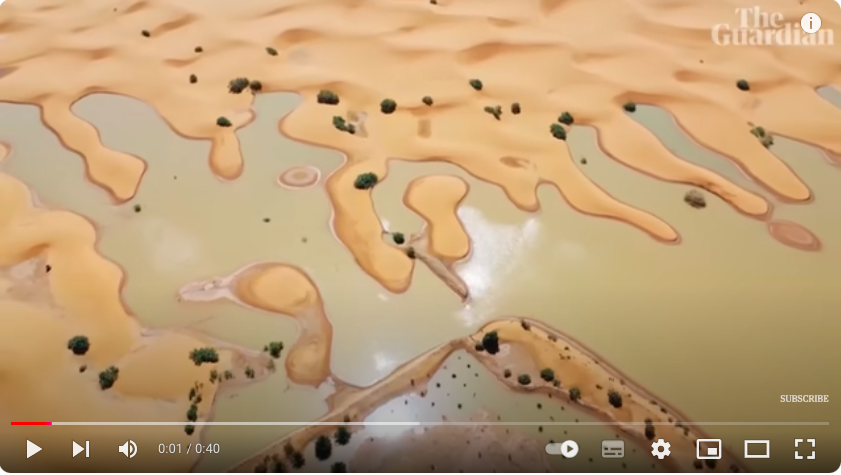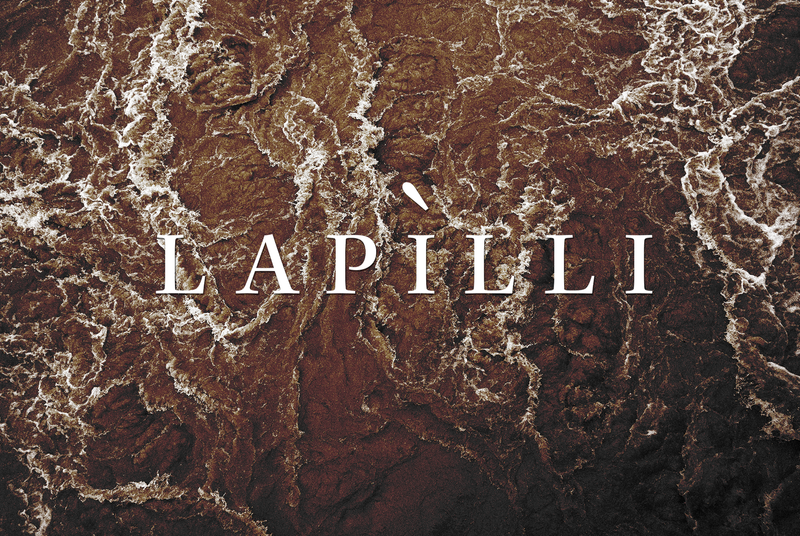In this issue of Lapilli, we focus on water — the vast amount of water that has arrived in exceptional quantities in Spain, France, Italy and the Balkans; as well as the rain that has turned the Sahara desert into an unusual landscape. We'll also explore what happens at sea when coastlines flood and the effects that these increasingly frequent extreme weather events have on mental health.
But first we want to introduce the first cohort of Magmatic School of Environmental Journalism: You can find who they are and what they'll be working on here!
As always we hope you will enjoy this newsletter as much as we enjoyed writing it. Feel free to forward and share it with whomever loves the Mediterranean sea as much as you do.

Mud and water. Even in October, heavy rain battered many parts of the Mediterranean. Only a few days ago, the Spanish regions of Valencia and Castilla-La Mancha received in eight hours the amount of rain that typically falls in a year, causing severe flooding and the death of at least 158 people as we finish writing this newsletter. Heavy rains often occur in this period in the western Mediterranean. This recurring phenomenon is called DANA, which stands for Depresión Aislada en Niveles Altos, meaning "isolated depression at high altitude." When this mass of cold air moves over the warm waters of the Mediterranean Sea, it allows the warmer, moist air at the surface to rise rapidly. This produces intense rain clouds. And the warmer the Mediterranean Sea becomes, the more intense the DANA gets (The New York Times). In the meantime, some preliminary attribution science analyses assessing how and how much global warming may have contributed to making the October 29 flooding event so destructive have already been released (Climática).

Intense rainfall, floods and landslides occurred also in central and southern Bosnia in early October. At least 26 people have died, and an entire lake was flooded with debris in the small village of Jablanica. The region had just come through an extremely dry and hot summer, with temperatures nearing 40 degrees Celsius (104 degrees Fahrenheit). Thus, the soil was unable to absorb the large quantities of rain that fell over such a short period of time.
Floods and intense weather events have also been recorded in southern France, and various parts of Italy. The Po River overflowed in Turin. In eastern Liguria, bridges turned into waterfalls. In Emilia-Romagna, 3,000 people were evacuated. In eastern Sicily, a “medicane” turned streets into rivers. For Emilia-Romagna in particular, this was the fourth flood in a year and a half. According to an analysis by ClimaMeter, the multiple floods that have recently struck Italy were driven by very exceptional meteorological conditions likely due to climate change triggered by human activities.
The repercussions at sea. The effects of the floods aren’t limited to the flooded areas but reach all the way to the sea. Just ask Manuele Merisio, a fisherman from Sestri Levante in Liguria. “When it rains and the streets flood, everyone thinks about the cities, but no one remembers what happens at sea,” says Merisio, who has been fishing bluefish in the Ligurian Sea for roughly 40 years.
After the recent heavy rains, all kinds of things end up in the sea. “It was full of plastic bottles, logs, and, along with the freshwater, a huge amount of soil and mud gets dumped, settling on the seabed,” he said. “The fish no longer like that ecosystem and disappear.”
Merisio said he has noticed how much the climate has changed, with downpours becoming stronger and more frequent, and how this has impacted his work schedule. In the 1980s, during the summer season, he would go out to fish almost every day, but in recent years, the good days — without mud, plastic and logs in the sea — have significantly decreased. Furthermore, bluefish, like anchovies and sardines, prefer clean water, and the type of fishing Merisio does depends on favorable weather conditions.
“This year, we had very few days of fishing because the weather is always bad,” he said, explaining that when the weather is bad, the sea changes color. “Here in the Ligurian Sea, when the water turns brown, everything incredibly disappears.”

The psychological effects of extreme events. In Italy alone, around 1,900 extreme weather events (downpours, hailstorms, tornadoes, floods, etc.) have been recorded up to September 15. All of this has a psychological impact on the many people affected. Journalist Alice Facchini wrote about the mental health consequences of extreme climate events in an article for Internazionale, using the floods in Tuscany and Emilia-Romagna on the one hand and the drought in Catalonia on the other as examples. Facchini reports how the differing nature of these intense phenomena leads to different psychological repercussions.
Floods, which occur quickly and are highly destructive, provoke intense stress and anxiety, even to the point of developing post-traumatic stress disorder. In contrast, drought, which gradually changes the landscape over time, evokes emotions more tied to depression and nostalgia for how things were before the changes. The paradox is that these events often alternate, increasing the psychological burden on people. In Bosnia, immediately after the recent flood, the World Health Organization mobilized to send psychologists to the field to support both those affected by the flood and the rescuers, emphasizing that it is not enough to rebuild homes and roads — people’s mental health must also be taken care of, too.
The rapid reconstruction of Derna. It’s been just over a year since the tragedy in Derna, the northeastern Libyan city that was devastated by a massive flood in September 2023 that resulted in the confirmed deaths of 5,000 people and thousands more missing. Reconstruction is proceeding but is somehow intertwined with the country's internal political rivalries. In 2023, the city was struck by Cyclone Daniel, and owing to its position at the end of Wadi Derna, a dry riverbed that only fills with water during rain, the flood's impact was catastrophic. Entire parts of the city were leveled, swept away by the force of the water in the middle of the night after several dams suddenly collapsed. Though reconstruction is proceeding quickly, General Khalifa Haftar appears to be taking advantage of this opportunity to expand his power and control over eastern Libya (Nzz).

Longer, more intense and deeper marine heatwaves. According to the eighth State of the Oceans Report prepared by the Copernicus Marine Service, which is part of the European Union's Earth observation program, the Mediterranean Sea is highly vulnerable to climate change, with marine extreme events becoming more frequent and intense. Marine heatwaves, deep-water warming and phytoplankton blooms are having a significant impact on the ecology of our sea. The increasingly intense and prolonged marine heatwaves threaten marine ecosystems, biodiversity and human activities, such as fishing and aquaculture. These heatwaves are now reaching deeper waters, amplifying their effects on the entire marine environment. The report also emphasizes the importance of implementing and improving monitoring systems, research and sustainable management to mitigate these impacts and protect both marine life and the coastal communities that rely on the Mediterranean Sea for their livelihood.
The role of the jet stream in climate and agriculture. A group of scientists has managed to reconstruct the path of the jet stream over the last 700 years by studying tree rings. The jet streams are those air currents moving in the stratosphere, often mentioned in the news when they propel airplanes to supersonic speeds. The study published in Nature reveals how the direction and position of the jet stream affect European summer weather patterns. When the jet stream is positioned far north, it creates wet and cool conditions from the British Isles to Belgium, while causing very hot summers in regions including Italy, Greece and the Balkans. Conversely, if the jet stream shifts further south, summers become hotter in the British Isles and wetter and cooler in the Mediterranean.
“We link tiny, subcellular cell wall features in the wood to atmospheric winds that weave through the atmosphere many miles above the Earth, which is fascinating,” said Valerie Trouet, leading author of the research.
Data from tree rings was then cross-referenced with historical records, such as chronicles of storms, epidemics and grape and crop harvest reports from specific years, which are abundant in European historical archives. The aim is to provide a historical data foundation on the jet stream’s path to better understand its future evolution and the atmospheric conditions we can expect (Phys.org).

Resilient Vintners. Speaking of harvests: For those who haven’t read or received it, in the latest edition of Lapilli+, journalist Soleded Dominguez highlights how winemakers in a village in southern France are introducing drought-resistant grape varieties, modified pruning and soil improvement techniques to adapt to climate change and new market trends. Since this is a project developed independently of Magma, we’ve decided to make the article fully accessible to everyone to promote their work. You can read it here.

A flooded desert. In Morocco, between September and October, rainfall reached levels unseen for decades, flooding parts of the Sahara Desert and creating an unusual landscape of water, sand and desert (The Guardian; Rainews). According to recent research, the future of the Sahara could see an increase in extreme rainfall events, linked to global warming caused by fossil fuels and its impact on the water cycle (CNN). This year, the entire southern Sahara region has experienced increased rainfall and photo comparisons clearly show how parts of the desert have given way to vegetation.


GUGLIELMO MATTIOLI
As a multimedia producer, he has contributed to innovative projects using virtual reality, photogrammetry, and live video for The New York Times. In a past life, he was an architect and an urban planner, and many of the stories he produces today are about the built environment. He has worked with publications such as The New York Times, The Guardian, and National Geographic. He has been living and working in New York City for more than 10 years.That's it for this month. Thank you for reading this far. See you in December or earlier with Lapilli+.
If this newsletter was forwarded to you, you can subscribe here to continue receiving it. Lapilli is free and always will be, but in case you would like to buy us a coffee or make a small donation, you can do so here. Thank you!
Lapilli is the newsletter that collects monthly news and insights on the environment and the Mediterranean, seen in the media and selected by Magma.

